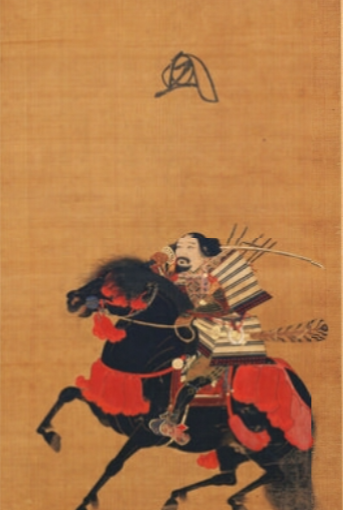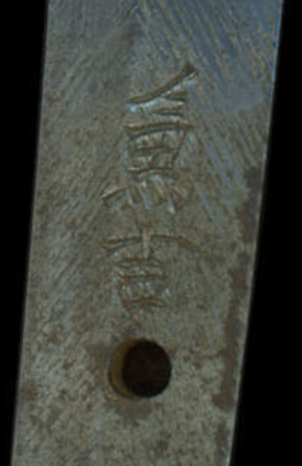-
Posts
4,291 -
Joined
-
Last visited
-
Days Won
96
Content Type
Profiles
Forums
Events
Store
Downloads
Gallery
Everything posted by SteveM
-

Help needed with the translation of this mei.
SteveM replied to b.hennick's topic in Translation Assistance
I think 承應元年壬辰十二月拾八日梅津於尼崎 三つ胴切落物集女九兵衛(花押) -
And to add to John's correct post above, the flag is presented to a Mr. INOKUCHI Asaharu (井口朝春). This is the name to the right of the "good luck in battle" phrase mentioned above. INOKUCHI is the surname (family name) of the person to whom the flag was presented. There are other possible readings in addition to INOKUCHI (for example, it may also be read as IGUCHI). The flag was presented by the "Young Men's Association of the 13th Precinct". It would take a bit more research to pinpoint the exact location of that precinct. Most of the rest of the writing would be the names of the signers. Looks legitimate to me.
-
大津絵にも囗囗ハ いかに囗囗囗 Ōtsue ni mo ~ Ikani ~ Even in Ōtsue --- I can't pick out the other bits. The reference is to a kind of folk art called "Ōtsue”, which you are probably already aware of.
-
I would also caution against drawing hard conclusions based on machine translations of the texts above. Japanese language contains a lot of subtleties and ambiguities which can go missing, or can get translated into non-negotiable English terms, when translated by google or AI. Plus, the translations often stumble over kanji, which themselves contain information that may get lost in translation.
-
Yes Enpō 7 (己未) year of the sheep
-
Tsuba should be right side: 城州西陣住 left side: 埋忠橘重義 Jōshū Nishijin-jū Umetada Tachibana Shigeyoshi
-

Can anybody give me any information on this .thanks
SteveM replied to bullet's topic in Military Swords of Japan
近江大掾藤原忠廣 Ōmi Daijō Fujiwara Tadahiro (Made by Tadahiro Fujiwara, Lord of Ōmi Province). -
The original contains the kaō of the second Ashikaga shogun, Yoshiakira, and the image was supposed to have been that of the first Ashikaga shogun, Takauji, but lately there is a line of inquiry that says the image is that of Kō no Moronao or his son. In any case, mid 1300s. source https://emuseum.nich...&content_pict_id=002
-
Here are a couple of Kaneyoshi inscriptions from WW2 era swords. The mei is placed above the peg hole, near the center of the blade. File marks are sloping upwards towards the ridge line. Both the "kane" (兼) and "yoshi" (吉) characters are well defined, and not overly "chippy". The patina is as one would expect on a WW2 sword. Only one peg hole, which is common as the swords were made and then shipped off to war with their owner - there wasn't any need (or time) for drastic shortening. https://www.e-sword....katana/1210-1022.htm https://www.nipponto...swords8/NT331993.htm
-
The inscription is Yamano Kanjuro, but you are right in that the kaō does indeed look exactly like Nagahisa's kaō. I'll assume that the NBTHK didn't find anything suspicious in the cutting test mei (otherwise they might have made the subtle notation "to saidan mei ga aru" (i.e. "there is a cutting test inscription which says....."). This is their way of distancing themselves from any validation on the cutting test inscription. In other words, they use that phrase when they want to say "the sword is from so-and-so, and by the way there is also a cutting test inscription, but we make no claim about the validity of the cutting test inscription". But yes, an interesting observation.
-
No, this is not correct. There is a video somewhere of a guy who mistranslated some stuff and made this claim, and that video is causing this misinformation to ricochet around. In most cases, the number on the cutting test inscription refers to the number of bodies cut.
-
The paper says Gōshū Hikone-jū Mogarashi Sōten, but I wouldn't read anything special into this.
-
Did they mention this in some correspondence? I'm looking on their site and I can't find any mention.
-
No need to overthink this one. The inscription is clearly 刕 (and not 劦 as English text in the inserted photo seems to suggest). 江刕住宗典製 Gōshū Sōten-sei (Made by Sōten of Gōshū). (Moriyama-san beat me to it). The paper from Shibata (dated Feb 1979) says the same thing, and adds that is is from the "Mid Edo Era". I'd say this was more of a "shop signature" rather than the signature of a specific person, which is typical for Sōten pieces.
-
Myōchin is another possibility. Either Myōchin main line, or some later artist working in Myōchin style. They did this sort of mokume (wood-grain pattern) tsuba. https://www.nipponto...swords6/TB202360.htm https://www.e-sword.jp/tsuba/1710-6011.htm https://japaneseswor...suba-signed-myochin/
-
何-- 姿の小野ハ秋-- 在?の淋しき風の音すれ Not quite enough to get it, but some allusion to the "Aname" nozarashi theme mentioned in the thread below? I'm not sure about the bits in red. I'm taking a leap with these, but given the theme and the reference to Ono (Ono no Komachi, I think), its leading me to think it is talking about the apocryphal story of Ariwara Narihira finding the skull of his former lover Ono no Komachi in a field.
-

Skulls, bones, and grave markers—An interesting tsuba
SteveM replied to brentlewiis's topic in Tosogu
Should be Kikuchi Masahira (菊地正平) but there is no such smith listed in Wakayama's index. There are two Masahiras, but neither of them use the name Kikuchi. One is a Shōami artist, and the other uses the gō of Tetsugendō. So I'm a bit skeptical of the name. The inscription/poem also eludes me 骨---無---波---誰と too many blanks that need filling in, but some musing on bones, as you can guess just by looking at the theme without knowing any of the characters. I don't know if that orphaned bit of writing on the right side is part of the poem, or if it is something else (name of the poet, for example). -
Microdear cloths are often mentioned as the best, but most any microfiber cloth (a lense-cleaning cloth) will do. This is worth reading.
-
The same maker that is in this thread
-
I think it has more to do with the effect of the lacquer on the wood of a koshirae, rather than the fit of the koiguchi. By this I mean the wood of a shirasaya is a somewhat permeable/breathable material that allows for any residual moisture inside to escape outside the shirasaya, whereas the lacquer on a koshirae is an impermeable membrane, trapping moisture inside the saya and causing the blade to rust over the long term. This is the general belief, anyway. I don't know if there have been any scientific studies done to quantify this. (There might be some 2nd tier effect of repeated sheathing and unsheathing of the sword from the koshirae, causing the koiguchi to become loose, but it should never be so loose that the sword is rattling around inside the koiguchi). Hmmm. I'd say nihonto were the crucial tools of a certain class of people, and if they didn't baby those tools, the tools would quickly rust, and would cease to serve their function. I think babying nihonto is a tradition that is as old as the craft of swordmaking itself. Otherwise, there would be no beautiful old swords left today.
-

Is this tsuba signed TORIN (ie Tsuneshige)?
SteveM replied to Kurikata's topic in Translation Assistance
Yes - it definitely looks like Tōrin (東琳). There are two artists who used this name. One is Tsuneshige, as you noted (which I think is the right one in this case). Wakayama says Tsuneshige is known for brass tsuba in nadekaku shape, which yours clearly is. The other artist who used the name Tōrin, is an artist from the Tsuchiya school named Arichika (在親). Both are late Edo, but just from the evidence at hand I think yours is a Tsuneshige piece. -
Interesting. I've never heard of this before, but there are three bones in the head of a snapper that resemble farm implements, hence the name "Three Tools" that are circled in red in the picture that Dale posted. They are supposed to resemble a hoe, sickle, and rake. May also have been used in some kind of fortune-telling. Anyway, I found another example of a tsuba with this theme, so I think Dale hit the nail on the head with this. https://issuu.com/kogire-kai/docs/109_____
-
志号? (Wild guess. No idea of the meaning) And then 足立? (Adachi, which is a surname, and also a location in Tokyo.) No idea of the little bit at the end. But 定位 is also possible. Sorry, not much help.
-
唐団扇 Tō-uchiwa (Chinese-style fan) Made in December 1892, for a Mr. Okada.








